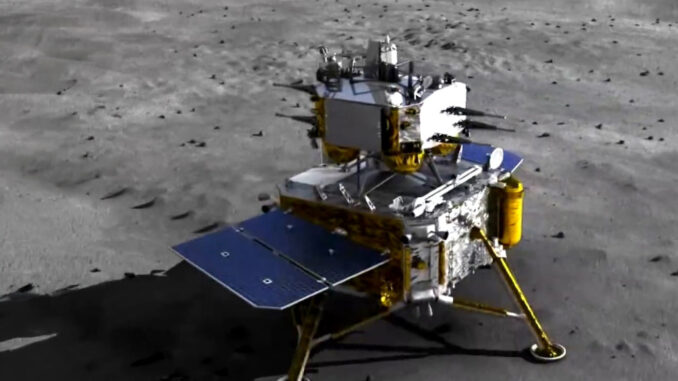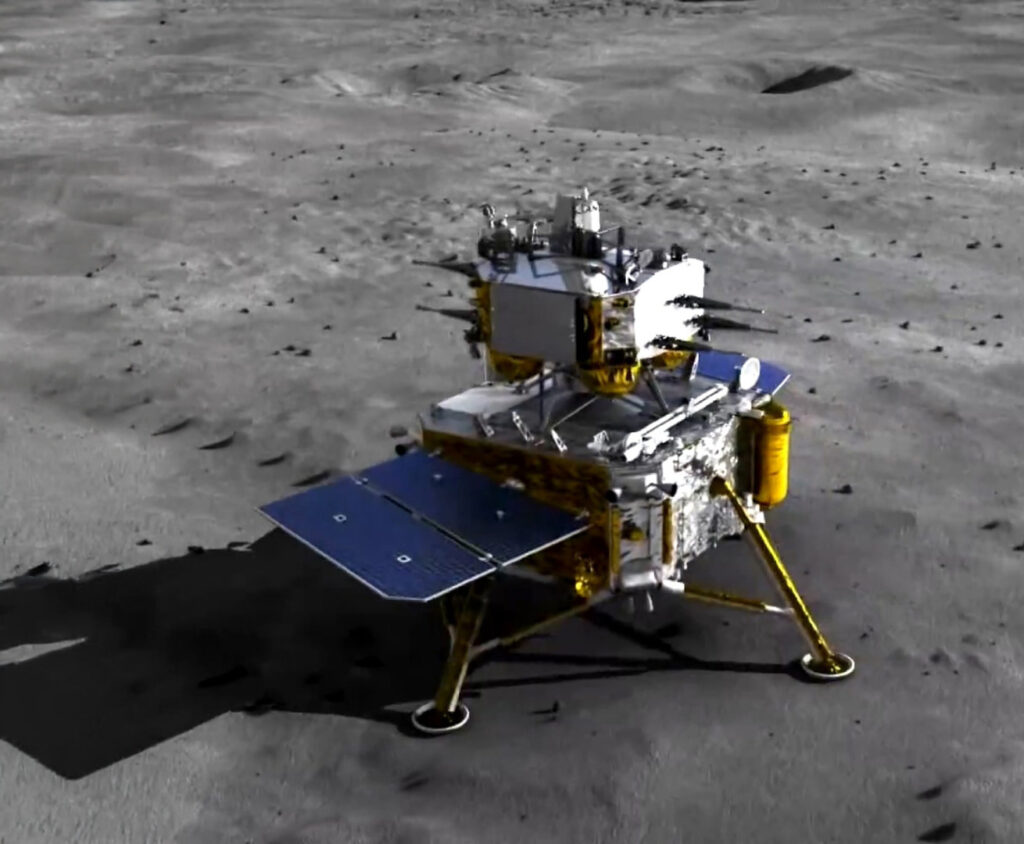
Chang’e-6 returns to Earth with samples from the far side of the Moon. A historic mission to understand lunar evolution.
The Chang’e-6 mission from the China National Space Administration (CNSA) is about to bring back to Earth the first samples from the far side of the Moon. After a complex 53-day mission involving landing, sample collection, ascent and docking, the re-entry capsule containing the precious samples is expected in Inner Mongolia on 25 June. This mission will enable in-depth research into the composition and evolution of the far side of the Moon, offering clues to the history of the solar system.
Chang’e-6: a historic lunar mission
How the mission unfolded
The Chang’e-6 mission was launched on 3 May 2024 aboard a Long March 5 rocket from the Wenchang launch site. After a journey of around five days, the Chang’e-6 service module reached lunar orbit. On 1st June, the descent module landed in the Apollo crater, located in the South Pole-Aitken basin, at a latitude of 41.6385°S and a longitude of 206.0148°E.
The ascent module then collected up to 2 kg of lunar material using a shovel and a drill. Around 49 hours later, it lifted off to join the service module in lunar orbit. The samples were transferred automatically to the re-entry capsule after docking, and the ascender was de-orbited shortly afterwards.
Importance of collecting samples from the far side of the Moon
The collection of samples from the far side of the Moon is a world first. These samples are crucial for understanding the differences between the two sides of the Moon. The far side, which never faces the Earth, has a distinct geological composition. By analysing these samples, scientists hope to uncover information about the geological processes and meteorite impacts that have shaped the Moon, as well as the history of the solar system.
The samples collected could reveal differences in chemical and mineralogical composition compared with samples from the visible surface, which have been extensively studied since the Apollo missions. This could also help to explain why the lunar crust is thicker on the far side.
Scientific and technological consequences
The results of the analyses of the Chang’e-6 samples will provide valuable data that could influence our understanding of planetary evolution. These data will make it possible to compare the Moon with other celestial bodies, in particular asteroids and terrestrial planets, thereby contributing to a better understanding of the formation and evolution of planetary systems.
In addition, this mission demonstrates China’s ability to carry out complex sample return missions, positioning the country as a leader in space exploration. The success of Chang’e-6 paves the way for even more ambitious future missions, such as Chang’e-7 and Chang’e-8, which will focus on the use of in situ resources and the technological tests needed to set up an international lunar research station.

International cooperation and contributions
Partnerships with ESA and other organisations
The Chang’e-6 mission benefited from international cooperation, particularly with the European Space Agency (ESA). ESA provided essential support through its ground stations and the Negative Ions on Lunar Surface (NILS) instrument for collecting data. This partnership demonstrates the importance of international collaboration in space exploration and could pave the way for future joint missions.
ESA Director Josef Aschbacher congratulated CNSA on the success of the mission, highlighting the fruitful collaboration between the two agencies. However, he also noted that this cooperation could come to an end, as the priorities and policies of the space agencies evolve.
Consequences of international cooperation
International collaboration on missions such as Chang’e-6 enables the sharing of knowledge, technologies and resources, which can accelerate progress in space exploration. They also foster scientific diplomacy, strengthening relations between the participating nations.
However, the end of some collaborations could slow progress in certain areas. The CNSA may have to look for new partners or strengthen its internal capabilities to maintain the pace of its space ambitions.
Future prospects for Chinese lunar exploration
Upcoming Chang’e missions
The Chang’e-6 mission is just one stage in China’s lunar exploration programme. The Chang’e-7 mission, scheduled for 2026, will focus on the search for resources and detailed mapping of the lunar surface. Chang’e-8, scheduled for 2028, will test technologies for collecting and using in situ resources, which are essential for future lunar bases.
These missions are precursors to the International Lunar Research Station (ILRS) project, planned for the early 2030s. This station will require super-heavy rocket launches and the collaboration of several countries and organisations for its construction and operation.
Sending Chinese astronauts to the Moon
Prior to the establishment of the ILRS, China plans to send astronauts to the Moon by 2030. This historic mission will mark the first time humans have landed on the Moon since the US Apollo missions in the 1970s. The CNSA is actively working on the technologies needed to ensure the success of this manned mission.
Implications for the race for lunar exploration
China’s lunar ambitions are strengthening international competition for the exploration and exploitation of lunar resources. While NASA and its partners are preparing the Artemis missions for a return to the Moon, China is moving ahead rapidly with its own plans. This dynamic could accelerate the pace of scientific discovery and technological innovation, while posing challenges in terms of managing international cooperation and competition in space.
The Chang’e-6 mission marks an important milestone in lunar exploration and strengthens China’s position as a major player in space exploration. The samples brought back will offer unprecedented insights into lunar geology and the history of the solar system, while paving the way for even more ambitious future missions. International cooperation remains crucial to maximise the benefits of these missions and to ensure that space exploration continues in a spirit of collaboration and knowledge sharing.
War Wings Daily is an independant magazine.